NUM2306 Case Study: Daniel's Laceration and Body's Response
VerifiedAdded on 2022/08/12
|5
|962
|15
Case Study
AI Summary
This case study focuses on Daniel, a 62-year-old man who sustained a large laceration to his left leg. The assignment delves into the inflammatory response triggered by the injury, discussing the various stages of wound healing, including hemostasis, inflammation, reconstruction, and maturation. It explores the roles of NF-kB, MAPK, and JAK-STAT pathways in inflammatory activity and how nursing care, including medications, addresses the body's response to injury. The study covers the clinical manifestations such as redness, swelling, and pain, and the critical microcirculatory activities involved. The assignment also provides a comprehensive overview of the physiological mechanisms in place for the body system to maintain homeostasis in response to injury, including a concept map to demonstrate the understanding of the topic.
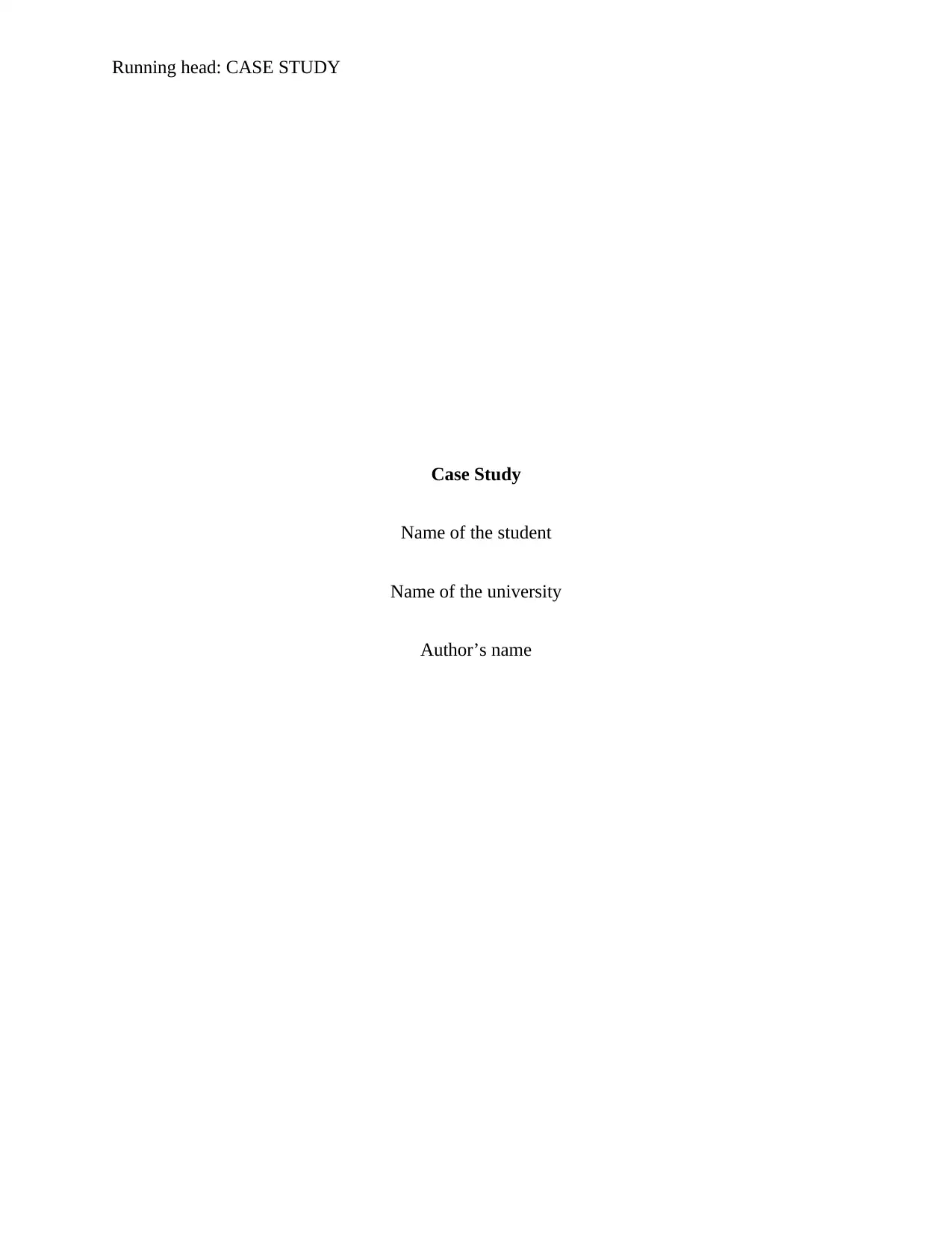
Running head: CASE STUDY
Case Study
Name of the student
Name of the university
Author’s name
Case Study
Name of the student
Name of the university
Author’s name
Paraphrase This Document
Need a fresh take? Get an instant paraphrase of this document with our AI Paraphraser
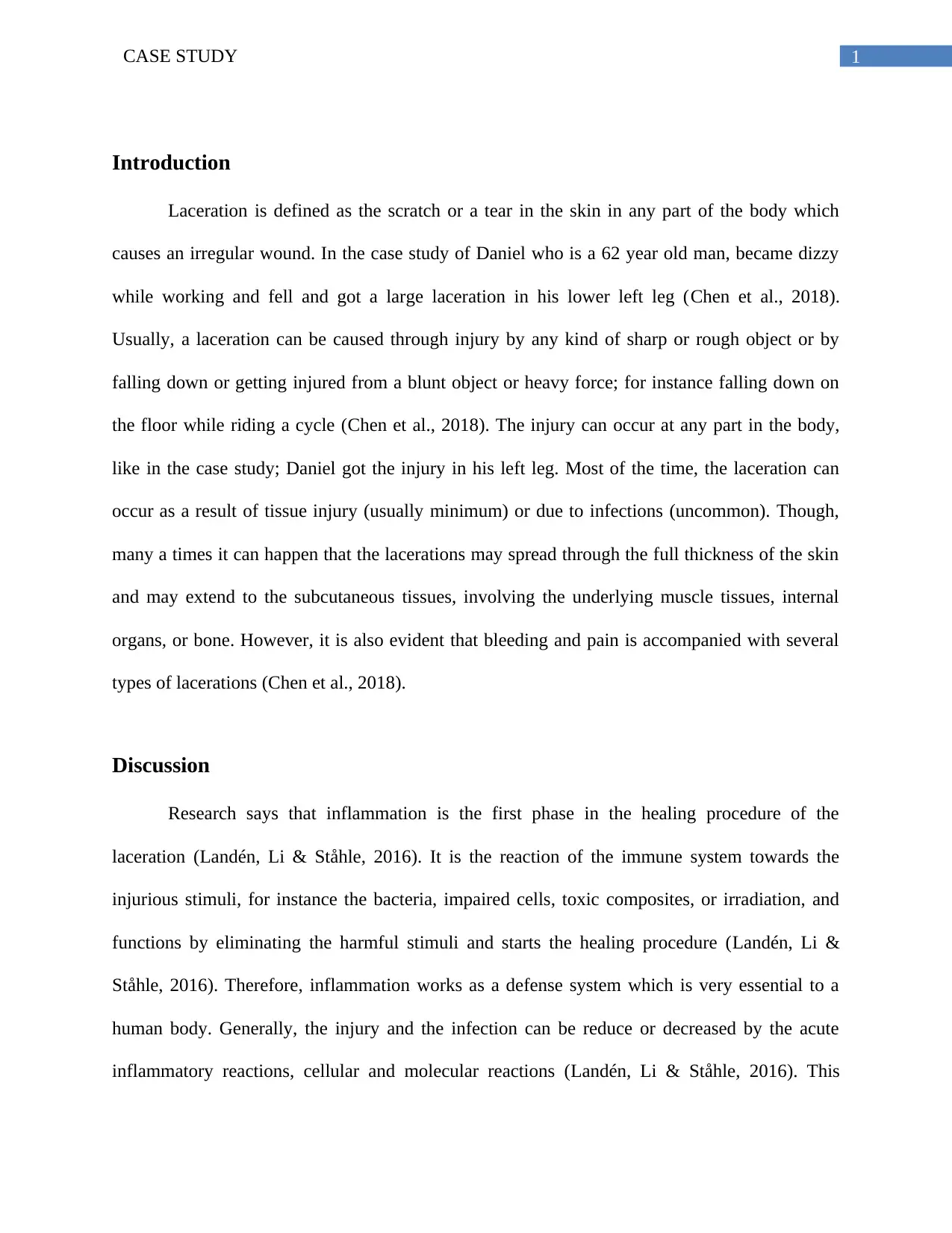
1CASE STUDY
Introduction
Laceration is defined as the scratch or a tear in the skin in any part of the body which
causes an irregular wound. In the case study of Daniel who is a 62 year old man, became dizzy
while working and fell and got a large laceration in his lower left leg (Chen et al., 2018).
Usually, a laceration can be caused through injury by any kind of sharp or rough object or by
falling down or getting injured from a blunt object or heavy force; for instance falling down on
the floor while riding a cycle (Chen et al., 2018). The injury can occur at any part in the body,
like in the case study; Daniel got the injury in his left leg. Most of the time, the laceration can
occur as a result of tissue injury (usually minimum) or due to infections (uncommon). Though,
many a times it can happen that the lacerations may spread through the full thickness of the skin
and may extend to the subcutaneous tissues, involving the underlying muscle tissues, internal
organs, or bone. However, it is also evident that bleeding and pain is accompanied with several
types of lacerations (Chen et al., 2018).
Discussion
Research says that inflammation is the first phase in the healing procedure of the
laceration (Landén, Li & Ståhle, 2016). It is the reaction of the immune system towards the
injurious stimuli, for instance the bacteria, impaired cells, toxic composites, or irradiation, and
functions by eliminating the harmful stimuli and starts the healing procedure (Landén, Li &
Ståhle, 2016). Therefore, inflammation works as a defense system which is very essential to a
human body. Generally, the injury and the infection can be reduce or decreased by the acute
inflammatory reactions, cellular and molecular reactions (Landén, Li & Ståhle, 2016). This
Introduction
Laceration is defined as the scratch or a tear in the skin in any part of the body which
causes an irregular wound. In the case study of Daniel who is a 62 year old man, became dizzy
while working and fell and got a large laceration in his lower left leg (Chen et al., 2018).
Usually, a laceration can be caused through injury by any kind of sharp or rough object or by
falling down or getting injured from a blunt object or heavy force; for instance falling down on
the floor while riding a cycle (Chen et al., 2018). The injury can occur at any part in the body,
like in the case study; Daniel got the injury in his left leg. Most of the time, the laceration can
occur as a result of tissue injury (usually minimum) or due to infections (uncommon). Though,
many a times it can happen that the lacerations may spread through the full thickness of the skin
and may extend to the subcutaneous tissues, involving the underlying muscle tissues, internal
organs, or bone. However, it is also evident that bleeding and pain is accompanied with several
types of lacerations (Chen et al., 2018).
Discussion
Research says that inflammation is the first phase in the healing procedure of the
laceration (Landén, Li & Ståhle, 2016). It is the reaction of the immune system towards the
injurious stimuli, for instance the bacteria, impaired cells, toxic composites, or irradiation, and
functions by eliminating the harmful stimuli and starts the healing procedure (Landén, Li &
Ståhle, 2016). Therefore, inflammation works as a defense system which is very essential to a
human body. Generally, the injury and the infection can be reduce or decreased by the acute
inflammatory reactions, cellular and molecular reactions (Landén, Li & Ståhle, 2016). This
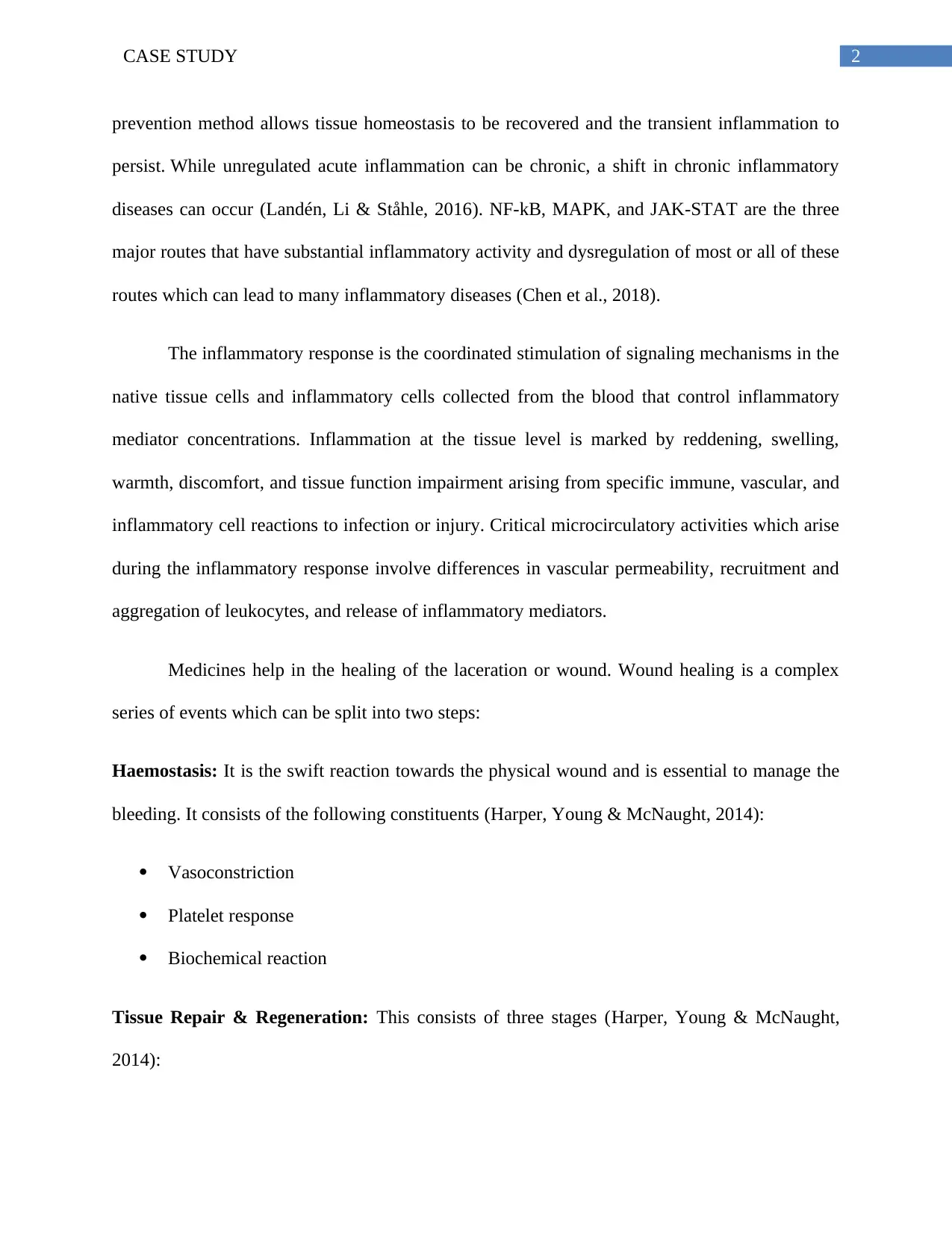
2CASE STUDY
prevention method allows tissue homeostasis to be recovered and the transient inflammation to
persist. While unregulated acute inflammation can be chronic, a shift in chronic inflammatory
diseases can occur (Landén, Li & Ståhle, 2016). NF-kB, MAPK, and JAK-STAT are the three
major routes that have substantial inflammatory activity and dysregulation of most or all of these
routes which can lead to many inflammatory diseases (Chen et al., 2018).
The inflammatory response is the coordinated stimulation of signaling mechanisms in the
native tissue cells and inflammatory cells collected from the blood that control inflammatory
mediator concentrations. Inflammation at the tissue level is marked by reddening, swelling,
warmth, discomfort, and tissue function impairment arising from specific immune, vascular, and
inflammatory cell reactions to infection or injury. Critical microcirculatory activities which arise
during the inflammatory response involve differences in vascular permeability, recruitment and
aggregation of leukocytes, and release of inflammatory mediators.
Medicines help in the healing of the laceration or wound. Wound healing is a complex
series of events which can be split into two steps:
Haemostasis: It is the swift reaction towards the physical wound and is essential to manage the
bleeding. It consists of the following constituents (Harper, Young & McNaught, 2014):
Vasoconstriction
Platelet response
Biochemical reaction
Tissue Repair & Regeneration: This consists of three stages (Harper, Young & McNaught,
2014):
prevention method allows tissue homeostasis to be recovered and the transient inflammation to
persist. While unregulated acute inflammation can be chronic, a shift in chronic inflammatory
diseases can occur (Landén, Li & Ståhle, 2016). NF-kB, MAPK, and JAK-STAT are the three
major routes that have substantial inflammatory activity and dysregulation of most or all of these
routes which can lead to many inflammatory diseases (Chen et al., 2018).
The inflammatory response is the coordinated stimulation of signaling mechanisms in the
native tissue cells and inflammatory cells collected from the blood that control inflammatory
mediator concentrations. Inflammation at the tissue level is marked by reddening, swelling,
warmth, discomfort, and tissue function impairment arising from specific immune, vascular, and
inflammatory cell reactions to infection or injury. Critical microcirculatory activities which arise
during the inflammatory response involve differences in vascular permeability, recruitment and
aggregation of leukocytes, and release of inflammatory mediators.
Medicines help in the healing of the laceration or wound. Wound healing is a complex
series of events which can be split into two steps:
Haemostasis: It is the swift reaction towards the physical wound and is essential to manage the
bleeding. It consists of the following constituents (Harper, Young & McNaught, 2014):
Vasoconstriction
Platelet response
Biochemical reaction
Tissue Repair & Regeneration: This consists of three stages (Harper, Young & McNaught,
2014):
⊘ This is a preview!⊘
Do you want full access?
Subscribe today to unlock all pages.

Trusted by 1+ million students worldwide
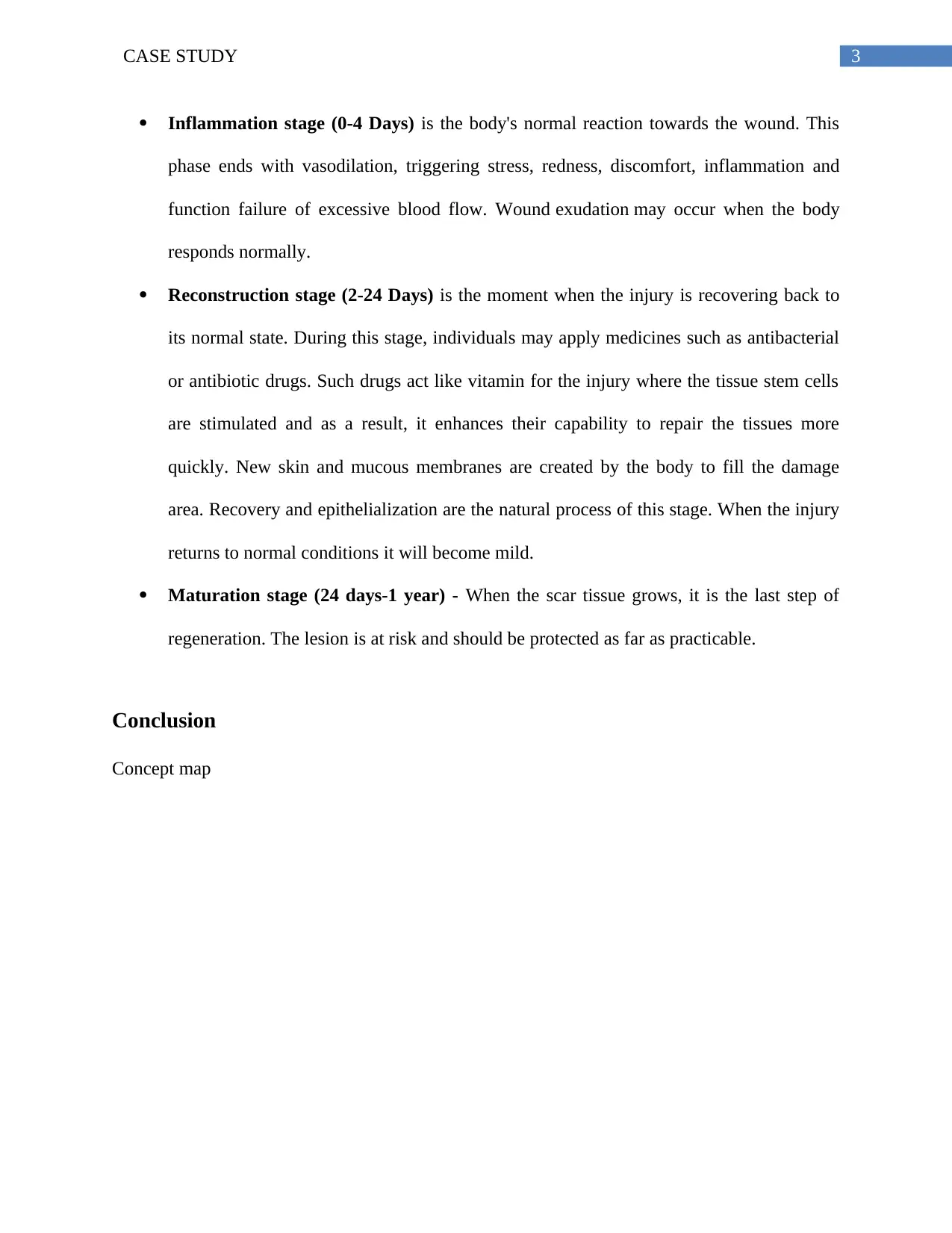
3CASE STUDY
Inflammation stage (0-4 Days) is the body's normal reaction towards the wound. This
phase ends with vasodilation, triggering stress, redness, discomfort, inflammation and
function failure of excessive blood flow. Wound exudation may occur when the body
responds normally.
Reconstruction stage (2-24 Days) is the moment when the injury is recovering back to
its normal state. During this stage, individuals may apply medicines such as antibacterial
or antibiotic drugs. Such drugs act like vitamin for the injury where the tissue stem cells
are stimulated and as a result, it enhances their capability to repair the tissues more
quickly. New skin and mucous membranes are created by the body to fill the damage
area. Recovery and epithelialization are the natural process of this stage. When the injury
returns to normal conditions it will become mild.
Maturation stage (24 days-1 year) - When the scar tissue grows, it is the last step of
regeneration. The lesion is at risk and should be protected as far as practicable.
Conclusion
Concept map
Inflammation stage (0-4 Days) is the body's normal reaction towards the wound. This
phase ends with vasodilation, triggering stress, redness, discomfort, inflammation and
function failure of excessive blood flow. Wound exudation may occur when the body
responds normally.
Reconstruction stage (2-24 Days) is the moment when the injury is recovering back to
its normal state. During this stage, individuals may apply medicines such as antibacterial
or antibiotic drugs. Such drugs act like vitamin for the injury where the tissue stem cells
are stimulated and as a result, it enhances their capability to repair the tissues more
quickly. New skin and mucous membranes are created by the body to fill the damage
area. Recovery and epithelialization are the natural process of this stage. When the injury
returns to normal conditions it will become mild.
Maturation stage (24 days-1 year) - When the scar tissue grows, it is the last step of
regeneration. The lesion is at risk and should be protected as far as practicable.
Conclusion
Concept map
Paraphrase This Document
Need a fresh take? Get an instant paraphrase of this document with our AI Paraphraser
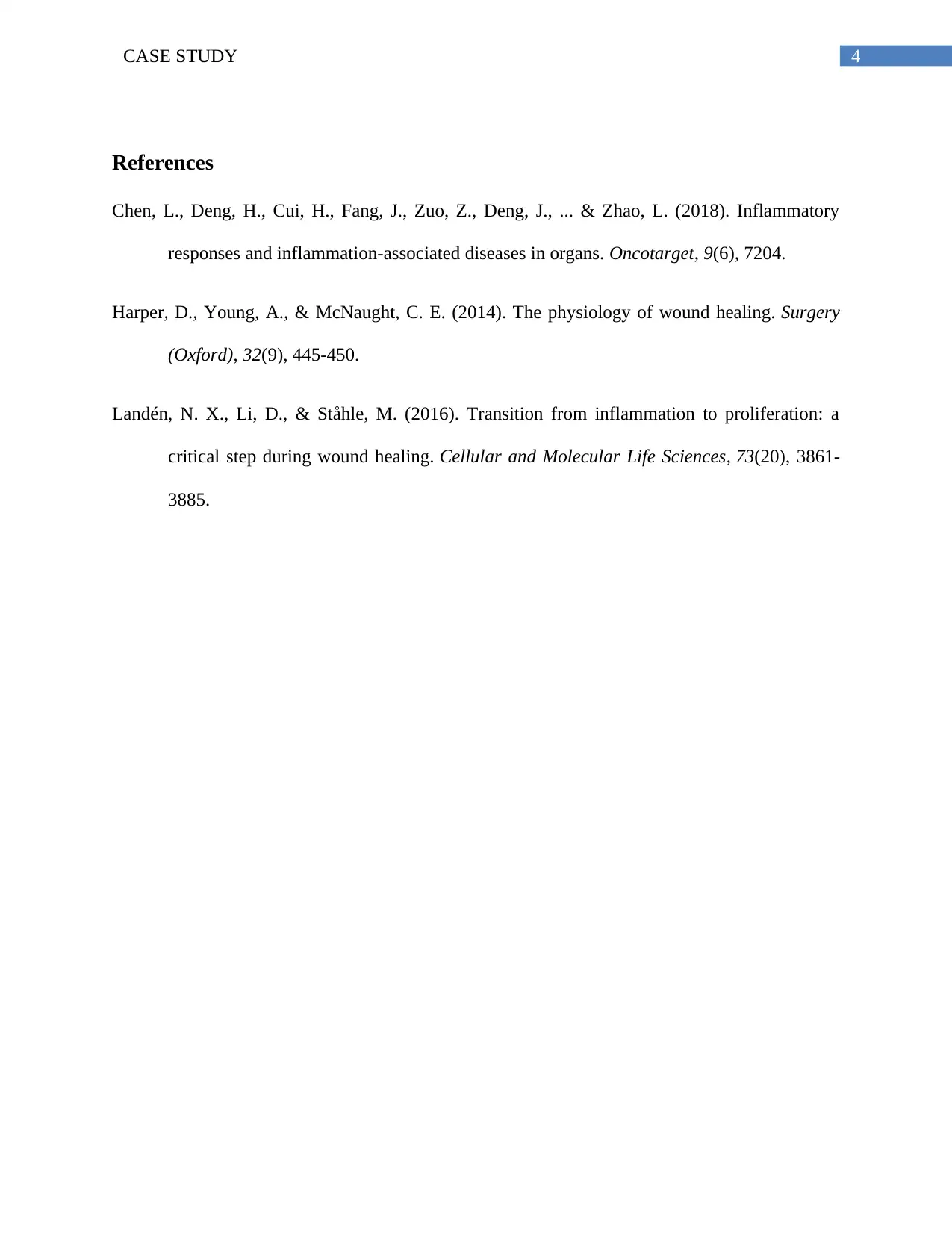
4CASE STUDY
References
Chen, L., Deng, H., Cui, H., Fang, J., Zuo, Z., Deng, J., ... & Zhao, L. (2018). Inflammatory
responses and inflammation-associated diseases in organs. Oncotarget, 9(6), 7204.
Harper, D., Young, A., & McNaught, C. E. (2014). The physiology of wound healing. Surgery
(Oxford), 32(9), 445-450.
Landén, N. X., Li, D., & Ståhle, M. (2016). Transition from inflammation to proliferation: a
critical step during wound healing. Cellular and Molecular Life Sciences, 73(20), 3861-
3885.
References
Chen, L., Deng, H., Cui, H., Fang, J., Zuo, Z., Deng, J., ... & Zhao, L. (2018). Inflammatory
responses and inflammation-associated diseases in organs. Oncotarget, 9(6), 7204.
Harper, D., Young, A., & McNaught, C. E. (2014). The physiology of wound healing. Surgery
(Oxford), 32(9), 445-450.
Landén, N. X., Li, D., & Ståhle, M. (2016). Transition from inflammation to proliferation: a
critical step during wound healing. Cellular and Molecular Life Sciences, 73(20), 3861-
3885.
1 out of 5
Related Documents
Your All-in-One AI-Powered Toolkit for Academic Success.
+13062052269
info@desklib.com
Available 24*7 on WhatsApp / Email
![[object Object]](/_next/static/media/star-bottom.7253800d.svg)
Unlock your academic potential
Copyright © 2020–2025 A2Z Services. All Rights Reserved. Developed and managed by ZUCOL.




